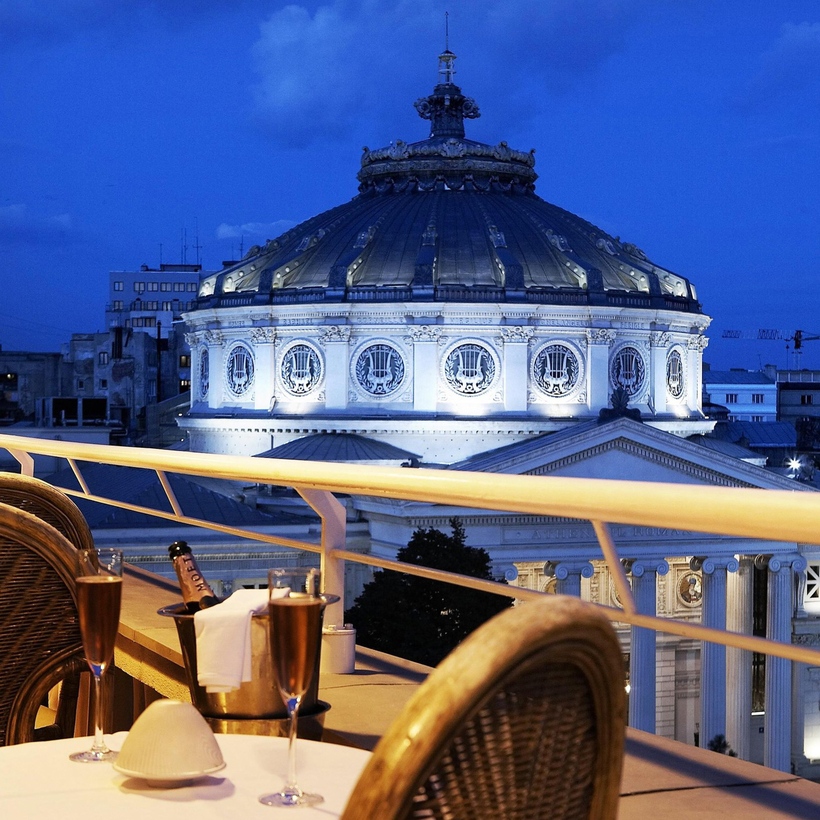Four years before he published Ten Days That Shook the World, his epic account of the Bolshevik Revolution, the American journalist John Reed traveled to the Balkans in 1915 to cover the First World War. After journeying into the dark heart of the conflict, he would return to Romania, where the war had not yet arrived. There, holed up in Bucharest’s Athénée Palace Hotel, Reed wrote his dispatches and his book The War in Eastern Europe.
Reed loved the Athénée Palace. From his room “high up in the dazzling neo-French façade,” he had a spectacular view of Romania’s capital city. On his left was the Ateneul, the city’s ornately domed neoclassical concert hall. On the right stood the royal palace. Beyond that was a vista of “red-tile roofs and white-stone copings … palaces and mansions and hotels of the most florid modern French style, with an occasional Oriental dome or the bulb of a Rumanian Greek Church.”
Holed up in Bucharest’s Athénée Palace Hotel, Reed wrote his dispatches and his book The War in Eastern Europe.
When it opened the previous year, the Athénée Palace was one of the Continent’s grandest hotels. Designed by the French architect Théophile Bradeau, its 159 rooms were sumptuously appointed with Louis XIV furniture; the vast lobby, with its rows of double Corinthian marble columns, was lit by immense crystal chandeliers. Guests could sit for hours over Turkish coffee or plum brandy with a view of the politicians, diplomats, oilmen, journalists, and aristocrats who gathered there. A door in back led to the American Bar, the favorite watering hole for war correspondents and expats. It would become the English Bar, re-christened by the author Olivia Manning, whose sojourn in Bucharest in 1939 and 1940 inspired the first two books of her Balkan Trilogy.

If you wanted to witness history, the Athénée Palace offered a front-row seat. It was home in the 1930s to the legations of the Spanish Republic and the young Soviet Union. After the fall of France, in 1940, it briefly served as the last outpost of cosmopolitan Europe, a sanctuary for wealthy refugees, businessmen, and occasional royalty fleeing Hitler’s armies. All the foreign correspondents were billeted there, including the New York Times’s C. L. Sulzberger, and R. G. Waldeck, a self-styled countess who wrote for Newsweek.
A sanctuary for wealthy refugees, businessmen, and occasional royalty fleeing Hitler’s armies.
Few hotels have been as rife with intrigue. U.P.I.’s correspondent, a regular at the English Bar at the outset of World War II, was an agent of the Communist International. The British had spies in residence, as did the Gestapo. The most enigmatic, as described in Waldeck’s book, Athene Palace, was the “exceedingly chic and soignée” Edit von Coler, who occupied a fourth-floor suite, drove around Bucharest in a silver Mercedes, and was rumored to be Heinrich Himmler’s sister.
In 1944—after Russian troops occupied Bucharest, but before the Cold War began—the hotel was used by American diplomats and O.S.S. agents. Four years later, with the country under Soviet control, the Athénée Palace was nationalized. Every room was bugged by the Securitate, Romania’s powerful secret police, every phone tapped. The hotel’s general director was an undercover colonel in the Counterespionage Directorate. “The doormen did surveillance; the housekeeping staff photographed all documents in the guests’ rooms,” the poet and publisher Dan Halpern wrote in 2009. “The prostitutes in the lobby and in the bar and in the nightclub reported directly to their employers.”
Every room was bugged by the Securitate, Romania’s powerful secret police, every phone tapped.
Reed’s “dazzling” fin de siècle façade was replaced in 1937 with a sleek white Art Deco exterior, one of several changes history has wrought. Damaged in 1944 when Bucharest was bombed, first by Allied forces and then by the Luftwaffe, the hotel underwent repairs in 1945 and was expanded in the 1960s. Nicolae Ceausescu was overthrown and executed in December 1989. After that, the Athénée limped along until Hilton Hotels bought it and, after a $42 million renovation, reopened it in 1997.
These days, the Athénée Palace Hilton features a state-of-the-art health club and five-star amenities. The crowd in the English Bar tends more to Western business executives, and the lobby teems with rich young Romanians, not displaced aristocrats. But for those who want to fall luxuriously back into history, the view is still there, though the Royal Palace is now the national art museum. Revolution Square still stretches before you, and at night the car headlights streaming by on the Calea Victoriei shimmer like a river of jewels.
Suzanna Andrews is a journalist whose articles have appeared in The New York Times, Vanity Fair, Rolling Stone, and more


